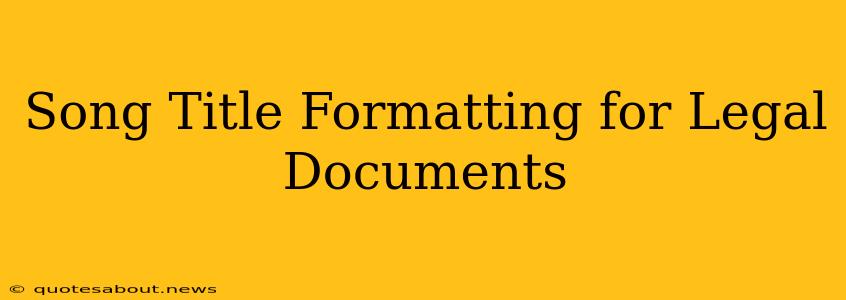Song titles hold a unique position in legal documents, often requiring specific formatting to avoid ambiguity and ensure clarity. Whether you're dealing with copyright infringement, licensing agreements, or simply referencing a song in a legal context, proper formatting is crucial. This guide provides a comprehensive overview of best practices for formatting song titles in legal documents, covering various styles and addressing common questions.
Why Proper Song Title Formatting Matters
Inaccurate or inconsistent formatting can lead to confusion and potential legal issues. A seemingly minor error in capitalization or punctuation could lead to disputes over copyright ownership or licensing rights. Courts rely on precise language, and ambiguous song title references weaken your case. Consistent formatting also demonstrates professionalism and attention to detail, crucial aspects in legal contexts.
Standard Formatting Styles for Song Titles
Several style guides exist for legal writing, but consistent application within a single document is key. Here are some common approaches:
-
Italics: This is a widely accepted method, particularly when referencing a song title within a larger body of text. For example: Dancing Queen or Stairway to Heaven.
-
Quotation Marks: Some legal styles prefer quotation marks, especially for shorter song titles. However, italics are generally preferred for their visual distinction. Example: "Bohemian Rhapsody" or "Like a Rolling Stone".
-
Capitalization: Generally, follow the original capitalization of the song title as it appears on the official release. Do not alter capitalization unless you are adhering to a specific style guide that dictates otherwise.
Common Questions Regarding Song Title Formatting
This section addresses frequently asked questions surrounding the formatting of song titles in legal contexts.
How should I format a song title that includes a subtitle?
If a song has a subtitle (e.g., "Strawberry Fields Forever" (Reprise)), maintain the original formatting from the official release. If using italics, italicize the entire title, including the subtitle. If using quotation marks, place quotation marks around the entire title, including the subtitle, maintaining the original spacing and punctuation.
What if the song title contains special characters or punctuation?
Reproduce the song title exactly as it appears on the official release, including any special characters or punctuation. Avoid altering these elements to maintain accuracy and avoid potential legal complications.
Should I use all caps for emphasis?
No, avoid using all caps for song titles in legal documents. While it might seem like a way to emphasize the title, it is generally considered unprofessional and can appear shouting. Stick to the original capitalization or use italics/quotation marks for emphasis where appropriate.
How do I cite a song in a footnote or bibliography?
Similar to in-text formatting, consistent application of italics or quotation marks for song titles in footnotes and bibliographies is crucial. Refer to the specific style guide (e.g., Bluebook, ALWD) for the correct format for your citation.
Should I abbreviate a song title?
Avoid abbreviating song titles unless the abbreviation is universally understood and used in the context of the song itself. Using full titles ensures clarity and avoids potential misunderstandings.
Conclusion
Accurate and consistent formatting of song titles in legal documents is paramount. By adhering to the guidelines outlined above, you minimize the risk of errors and ensure your documents are clear, professional, and legally sound. Remember, consistency and adherence to established legal style guides are key. If you have any doubts, it is always best to err on the side of caution and use the original title formatting as accurately as possible.

